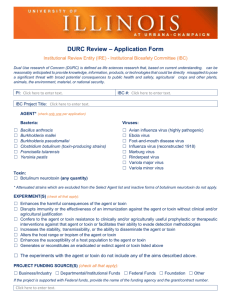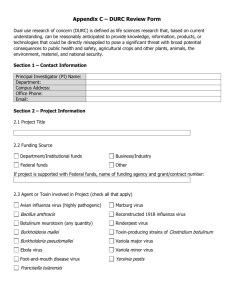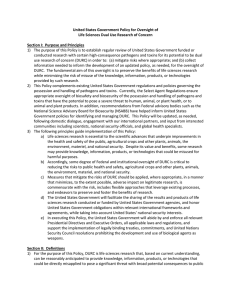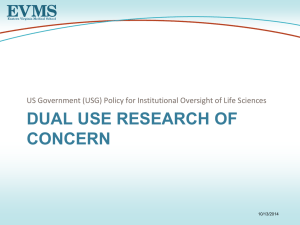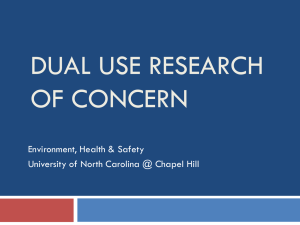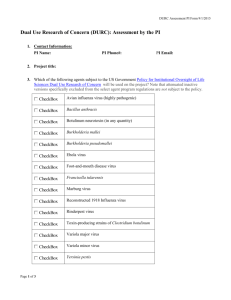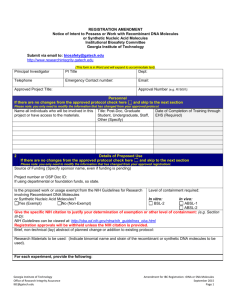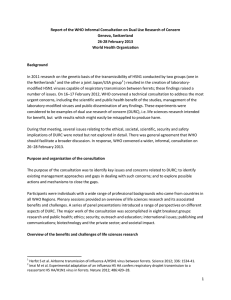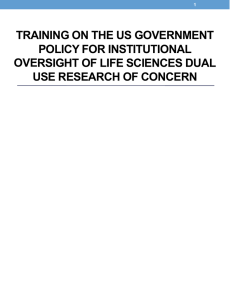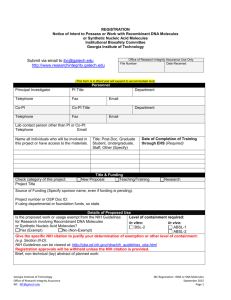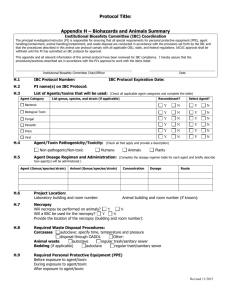word doc - University of Texas Health Science Center at Houston
advertisement
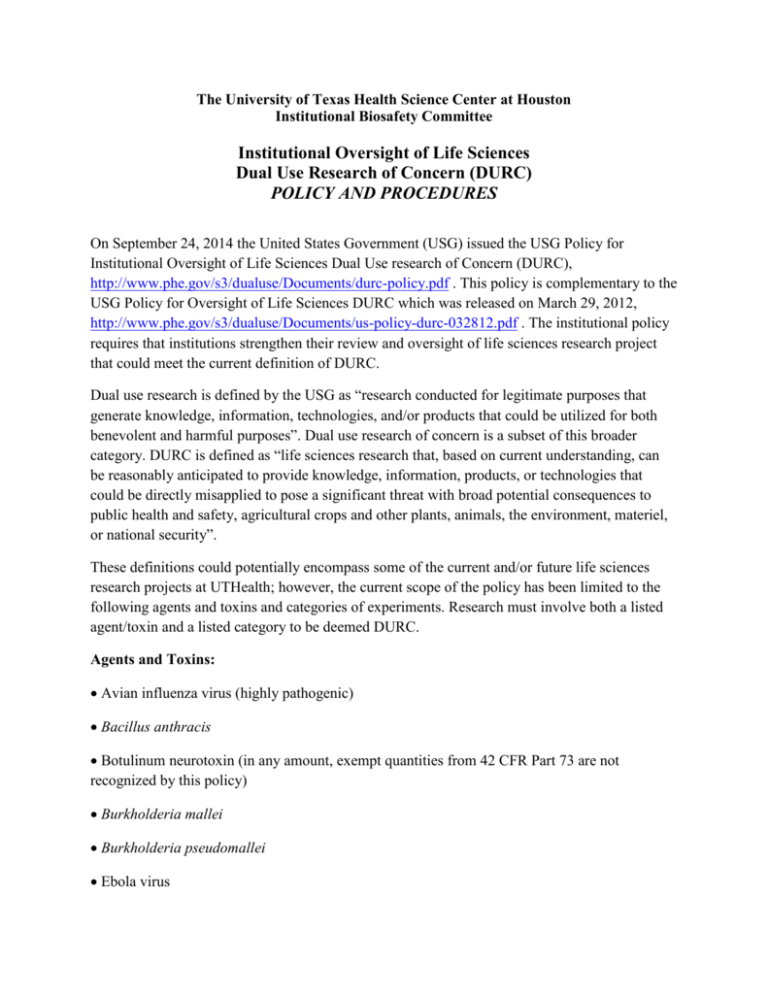
The University of Texas Health Science Center at Houston Institutional Biosafety Committee Institutional Oversight of Life Sciences Dual Use Research of Concern (DURC) POLICY AND PROCEDURES On September 24, 2014 the United States Government (USG) issued the USG Policy for Institutional Oversight of Life Sciences Dual Use research of Concern (DURC), http://www.phe.gov/s3/dualuse/Documents/durc-policy.pdf . This policy is complementary to the USG Policy for Oversight of Life Sciences DURC which was released on March 29, 2012, http://www.phe.gov/s3/dualuse/Documents/us-policy-durc-032812.pdf . The institutional policy requires that institutions strengthen their review and oversight of life sciences research project that could meet the current definition of DURC. Dual use research is defined by the USG as “research conducted for legitimate purposes that generate knowledge, information, technologies, and/or products that could be utilized for both benevolent and harmful purposes”. Dual use research of concern is a subset of this broader category. DURC is defined as “life sciences research that, based on current understanding, can be reasonably anticipated to provide knowledge, information, products, or technologies that could be directly misapplied to pose a significant threat with broad potential consequences to public health and safety, agricultural crops and other plants, animals, the environment, materiel, or national security”. These definitions could potentially encompass some of the current and/or future life sciences research projects at UTHealth; however, the current scope of the policy has been limited to the following agents and toxins and categories of experiments. Research must involve both a listed agent/toxin and a listed category to be deemed DURC. Agents and Toxins: Avian influenza virus (highly pathogenic) Bacillus anthracis Botulinum neurotoxin (in any amount, exempt quantities from 42 CFR Part 73 are not recognized by this policy) Burkholderia mallei Burkholderia pseudomallei Ebola virus Foot-and-mouth disease virus Francisella tularensis Marburg virus Reconstructed 1918 influenza virus Rinderpest virus Toxin-producing strains of Clostridium botulinum Variola major virus Variola minor virus Yersinia pestis Categories of Experiments: Enhances the harmful consequences of the agent or toxin Disrupts immunity or the effectiveness of an immunization against the agent or toxin without clinical and/or agricultural justification Confers to the agent or toxin resistance to clinically and/or agriculturally useful Prophylactic or therapeutic interventions against that agent or toxin or facilitates their ability to evade detection methodologies Increases the stability, transmissibility, or the ability to disseminate the agent or toxin Alters the host range or tropism of the agent or toxin Enhances the susceptibility of a host population to the agent or toxin Generates or reconstitutes an eradicated or extinct agent or toxin listed above Under the institutional policy specific responsibilities related to the review, oversight and reporting to USG funding agencies and/or the National Institutes of Health Program on Biosecurity and Biosafety Policy (NIH PBBP, http://osp.od.nih.gov/officebiotechnologyactivities/biosecurity/dual-use-research-concern ) are to be shared by the Principal Investigator (PI), the Institutional Review Entity (IRE) and the designated Institutional Contact for Dual Use Research (ICDUR). If DURC research is funded by a USG agency required reports should be made to the funding agency. For DURC research that is not funded by a USG agency required reports should be made to the NIH. Effective implementation of the provisions of the institutional DURC policy at UTHealth will involve partnership between the Institutional Biosafety Committee (IBC), Biological Safety Officer (BSO) and Biological Safety Program. Therefore, our current IBC will assume the role of the IRE for DURC. The current IBC is comprised of research faculty with a broad knowledge base in infectious agents, molecular biological techniques and containment strategies to mitigate risks associated with life sciences research. The current IBC protocol registration form captures the listed agents and toxins and the categories of experiments, thus prompting PIs to designate when DURC is being conducted and allowing the Biological Safety Program to assist PIs in the determination of research which may be categorized as DURC. Additionally, DURC information has been included in UTHealth’s annual basic laboratory training to ensure PIs are trained on this policy. The PI has the following responsibilities: Initially identifying life sciences research that may be DURC Working with the IBC to develop a risk mitigation plan Conducting approved DURC only after approval by the IBC and in accordance with the risk mitigation plan Being knowledgeable about DURC policies and educating lab personnel accordingly Communicating DURC responsibly when publishing or presenting experimental findings The IBC has the following responsibilities: Reviewing research projects that have been designated by the PI as potential DURC and conducting a risk assessment to determine if they are indeed DURC Working with the PI to determine the benefits of the research and, in conjunction with the previously developed risk assessment, developing a risk mitigation plan for the research Providing the draft risk mitigation plan to the USG funding agency and/or NIH within 90 calendar days Ensuring implementation of the risk mitigation plan Reviewing annually all active risk mitigation plans Maintaining records of DURC reviews and risk mitigation plans for at least the term of the research grant/contract plus three years but not less than eight years Providing education and training on DURC to research personnel Ensuring compliance with the policy among lab personnel The Institutional Contact for Dual Use Research (ICDUR) has the following responsibilities: Serving as the liaison, as necessary, between the institution and the USG funding agency and/or NIH Serving as the point of contact for the institution for questions regarding implementation of and compliance with the institutional DURC policy Notifying the USG funding agency and/or NIH within 30 calendar days that DURC has been identified Notifying the USG funding agency and/or NIH within 30 calendar days of any changes that would affect active risk mitigation plans or instances of non-compliance The Vice President of Safety, Health, Environment and Risk Management, Dr. Robert Emery has been designated as the ICDUR. If you have questions about DUR, contact Dr. Emery at 713500-8100, or the Biological Safety Program at 713-500-8170. Scott Patlovich, BSO and Director of Environmental Health and Safety, has been designated as the alternate ICDUR. Scott can be contacted at 713-500-8100. The effective date of implementation required by the institutional policy for DURC is September 24, 2015. The BSO will oversee the implementation process and assure that all required components are in place in advance of September 24, 2015. This policy has been reviewed and approved by the Institutional Biosafety Committee. ________________________________________ Institutional Biosafety Committee Chair ________________ Date
